
Galls or cecidia are a kind of swelling growth on the external tissues of plants, fungi, or animals. Plant galls are abnormal outgrowths of plant tissues, similar to benign tumors or warts in animals. They can be caused by various parasites, from viruses, fungi and bacteria, to other plants, insects and mites. Plant galls are often highly organized structures so that the cause of the gall can often be determined without the actual agent being identified. This applies particularly to some insect and mite plant galls. The study of plant galls is known as cecidology.
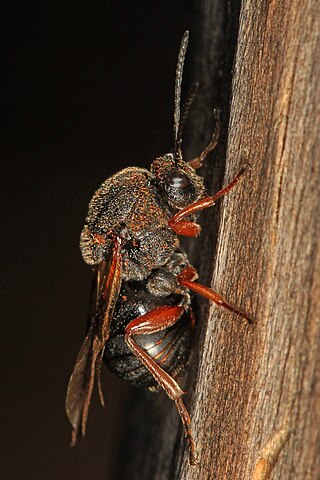
Gall wasps, also traditionally calledgallflies, are hymenopterans of the family Cynipidae in the wasp superfamily Cynipoidea. Their common name comes from the galls they induce on plants for larval development. About 1,300 species of this generally very small creature are known worldwide, with about 360 species of 36 different genera in Europe and some 800 species in North America.
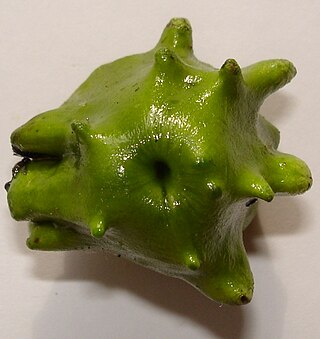
Andricus quercuscalicis is a gall wasp species inducing knopper galls.

Cynipini is a tribe of gall wasps. These insects induce galls in plants of the beech and oak family, Fagaceae. They are known commonly as the oak gall wasps. It is the largest cynipid tribe, with about 936 to 1000 recognized species, most of which are associated with oaks. The tribe is mainly native to the Holarctic. Cynipini wasps can act as ecosystem engineers. Their galls can become hosts of inquilines, and the wasps themselves are hosts to parasitoids.
Bassettia is a genus of gall wasps found in North America.
Bassettia pallida is a species of gall wasp found in the Southern United States. This species was described by American entomologist William Harris Ashmead in 1896. B. pallida reproduces asexually in galls it induces on oak trees. The parasite Euderus set, a eulophid wasp, has B. pallida as a host and manipulates its behavior.

Callirhytis is a genus of gall wasps in the family Cynipidae. There are more than 90 described species in Callirhytis. Wasps in this genus primarily induce wasps on oak trees in North America.
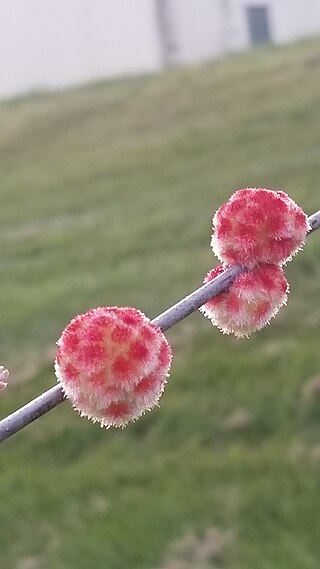
Callirhytis seminator, the wool sower, is a species of gall wasp in the family Cynipidae.

Callirhytis quercussuttoni, the gouty stem gall wasp, is a species of gall wasp. Its galls appear on oaks in the red oak group on the west coast of North America.

Melikaiella flora, formerly Callirhytis milleri, the live oak petiole gall wasp, is a species of hymenopteran that produces leaf galls on coast live oak, interior live oak, and canyon live oak trees in California in North America. The gall often subsumes the entire petiole and occasionally part of the leaf body. Pregnant females of the second generation oviposit on acorns; these acorns are usually dropped by the tree and become food for squirrels, deer, Steller's jays, etc.
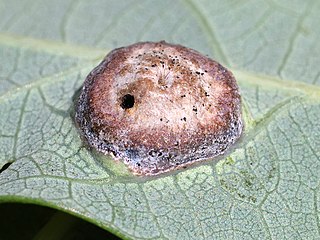
Callirhytis quercusfutilis, the oak wart gall wasp, is a species of gall wasp in the family Cynipidae.

Amphibolips quercuspomiformis, also known as the apple gall wasp or live oak apple gall wasp, is a species of gall wasp. It induces galls in coast live oak and interior live oak trees. Like many gall wasps, it has two alternating generations: a parthenogenic generation, and a bisexual generation. The galls formed by the all-female parthenogenic generation are spherical, up to 40 mm in diameter, and covered with short spines. They form on stems and are green or red when new, then turn brown. The galls formed by the bisexual generation are small, shaped like toadstools, and occur on leaves.

Callirhytis quercusagrifoliae, commonly known as the bud gall wasp, is a species of cypnid wasp that induces galls on the flower buds of coast live oaks and interior live oaks. This wasp has been observed in California in North America.

Callirhytis serricornis, formerly Andricus serricornis, the kernel flower gall wasp, is a species of hymenopteran that produces galls on oak trees in California in North America. The wasp oviposits on coast live oak and interior live oak and induces a gall shaped roughly like a bottle or vase. The gall is brown in the first generation, and red and green in the second.

Callirhytis perfoveata, formerly Andricus perfoveata, the leaf ball gall wasp, is a species of hymenopteran that produces leaf galls on oak trees in California in North America. The wasp oviposits on coast live oak, interior live oak, and occasionally on California black oak, and induces what appears to be a roughly spherical gall embedded within the leaf. The gall is initially bright green and turns brown as it ages.
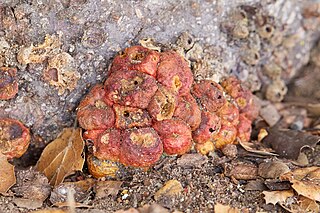
Callirhytis apicalis, formerly Andricus apicalis, the trunk gall wasp, is a species of hymenopteran that induces galls on the trunks or roots of black oak group trees in California in North America. Newly formed galls are red or yellow, turning brown as they age. This wasp is most often associated with Quercus agrifolia. This wasp is generally considered uncommon.

Callirhytis carmelensis, formerly Andricus carmelensis, the mottled acorn gall wasp, is a species of hymenopteran that induces galls on the acorns of coast live oaks and interior live oaks in California in North America. The purple or spotted green gall forms where the acorn attaches to the tree and often prevents normal development of the nut. The gall also produces a honeydew secretion that is attractive to other insects. This wasp is generally considered uncommon.

Callirhytis congregata, formerly Andricus congregata, the sausage flower gall wasp, is a species of hymenopteran that induces galls on the catkins of coast live oaks, interior live oaks, and canyon live oaks in California in North America. This wasp is considered locally common. William Harris Ashmead described Andricus congregatus as producing a gall like a "rugose, yellowish brown woody swelling, containing numerous cells growing apparently from the extreme tips of very slender twigs of Quercus chrysolepis, the gall appearing to have a long peduncle".

Callirhytis eldoradensis, formerly Andricus eldoradensis, the acorn gall wasp, is a species of hymenopteran that induces galls on the acorns of coast live oaks, interior live oaks, and canyon live oaks in California in North America. This gall is not as readily visible as some of the showier oak galls, but exit holes may be visible on the acorns, and galled acorns are likely to stay on the tree after other acorns have dropped. The unisexual generation of this wasp produces a modest bud gall.

















